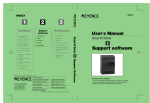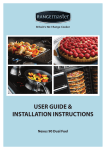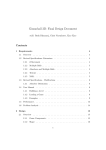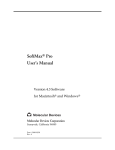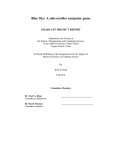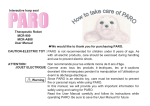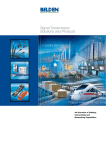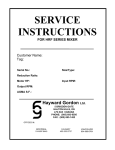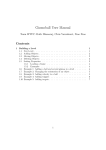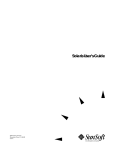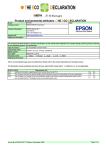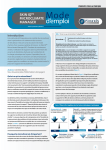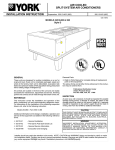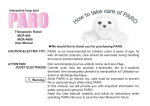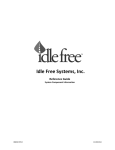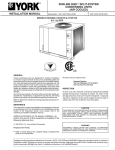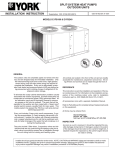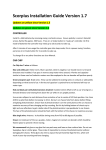Download 6.170 Final Project: Gizmoball
Transcript
6.170 Laboratory in Software Engineering
Fall 2005
Final Project: Gizmoball
Due: See Schedule
Contents:
•
•
•
•
•
•
•
•
•
•
•
Introduction
Gizmoball Overview
Awards
Grading, Deliverables and Schedule
o Weekly Meetings with TA
Resources
o Provided code
Hints
o General
o Coding
o Keypress
Keyboard events
On Windows
On Unix
Test Program
Solutions
Appendix 1: Detailed Requirements
o General
o Playing Area
o Building Mode
o Running Mode
o Standard Gizmos
Square Bumper
Circular Bumper
Triangular Bumper
Flipper
Absorber
Outer Walls
Appendix 2: The Gizmoball File Format
o Informal Description
o Semantics
Appendix 3: The physics package
Amendment
Errata
Note: Some 6.170 students have acquired Repetitive Strain Injuries (RSI) over the course
of the final project in the past. Don't let it happen to you. It hurts. Please read the MIT
server about RSI before embarking on the final project.
Introduction
This handout describes one of the two final project choices you have this term,
Gizmoball. For information on RSS Client, the other project, refer to handout in the
projects section.
The goal of the project is to design, document, build, and test a program that plays
Gizmoball. Gizmoball is a version of pinball, an arcade game in which the object is to
keep a ball moving around in the game, without falling off the bottom of the playing area.
The player controls a set of flippers that can bat at the ball as it falls.
The advantage of Gizmoball over a traditional pinball machine is that Gizmoball allows
users to construct their own machine layout by placing gizmos (such as bumpers,
flippers, and absorbers) on the playing field. These machine layouts may also form
complicated "Rube Goldberg" contraptions that are intended to be watched rather than
played. (If you don't know what a Rube Goldberg machine is, see
http://www.anl.gov/Careers/Education/rube/ or http://www.rube-goldberg.com/). As an
optional extension (after you have designed, documented, implemented, and tested all
required functionality), you may create new varieties of gizmos that can be placed on a
playing field.
Gizmoball Overview
Because this project is in part a design exercise, the assignment specifies what the user
should be able to do and leaves it up to you to figure out what modules and interfaces are
appropriate. This section gives an overview of Gizmoball. A more detailed specification
is given in Appendix 1. To enable automated testing, your implementation must support a
XML file format (defined in Appendix 2), in addition to the loosely-specified graphical
user interface.
Gizmoball has a graphical user interface with two modes, building mode and running
mode.
In building mode, a user can:
•
•
•
•
create and edit square, circular, and triangular bumpers on the playing surface,
create and edit flippers,
connect the action of flippers and bumpers to triggers, such as a keyboard key
being hit or one of the bumpers being bumped, and
save and load the user's game configuration to and from a file.
In running mode, the user can play the game.
A screenshot of one implementation of Gizmoball.
Your implementation will look different (depending on your choice of user interface),
and your ball motion may not match the animation given exactly.
The picture above illustrates the most important features of Gizmoball.
•
•
•
The gizmo palette on the side provides the user with a variety of operations
(square, circle, triangle, flipper) for placing gizmos in the playing area.
The "modifications" toolbar on the bottom provides the user with a variety of
operations (move, delete, rotate) for editing the gizmos in the playing area.
The modifications toolbar also provides a connect button that connects the trigger
of one gizmo to the action of another. After this button is pressed the user can
connect gizmos together. For example, the user might press the connect button,
then click on one of the circular bumpers, and then click on one of the flippers. As
a result, every time the bumper's trigger is activated (which occurs when a ball
hits the bumper), the flipper's action (to rotate around its pivot) will occur.
Alternatively, the user might press the connect button, then press a key, then
answer a question about whether the up or down keypress is of interest, then click
on one of the flippers. As a result, every time the user depresses (or, respectively,
releases) that key, the flipper will move. Several triggers may activate the same
gizmo.
•
•
The purple bar across the bottom of the playing area is the absorber gizmo.
When a ball enters the absorber, the ball stops moving and is held in the
absorber's lower right-hand corner. The absorber gizmo's action is to shoot a ball
it is holding (if any) straight up in the direction of the top of the playing area.
Connecting the absorber to itself allows the game to loop continually: every time
a ball enters the absorber, it is immediately shot out again.
The menu at the top of the window allows the user to save or load game
configurations and to run or stop the game. In the animation, a game is in
progress: the ball is the small blue circle which started in the lower right-hand
corner. The ball bounces off the red, green, and blue bumpers, and is hit by the
yellow flippers.
Awards
Each team may enter its Gizmoball implementation into a class contest for one or more of
the following awards:
•
•
•
Best Design: Awarded for the project with the best abstraction, modularity,
extensibility, simplicity, etc. The quality of the final report is also considered.
Best Gizmoball Game/Usability: Awarded for the project with the best gameplay and best user interface. Part of your submission for this prize should be an
input file that sets up the playing area; the prize is for the playable game itself, not
for the construction kit.
Most Artistic: Awarded for the project that is the most beautiful or fascinating to
watch. Part of your submission for this prize should be an input file that sets up
the playing area. When run with this input file, the ball or balls should bounce
around forever without the user needing to press any keys.
Whether your program implements only the basic required functionality orextra gizmos
etc. will not be considered when making the design award. However extra functionality
that improves game-play or "Rube Goldberg" artistry will be an asset in competing for
the other two awards.
Grading, Deliverables and Schedule
You'll do your project in phases, with the following milestones:
Phase
Deliverables
Due date
Preliminary
Design
Preliminary design document
Wed.
Nov. 9
Preliminary
Release
Source code, specifications, unit tests
Mon.
Nov. 21
Final Release
Final design document, source code, specifications, unit Mon.
tests, user manual, webstart packaging
Dec. 12
Each team will receive a single grade for the final project, determined as follows:
Category
Deliverable
Due date
Wed.
Preliminary
Nov. 9 at
design document
12 noon
Design
Final design
document
Team work
Mon.
Dec. 12 at
9AM
Weekly meetings weekly
Packaging
%
project
grade
Graded on
15%
Are key issues identified?
15%
Is design clean, robust and
flexible?
10%
Did team work well
together? Did all members
participate constructively?
User Manual
Mon.
Dec. 12 at
9AM
8%
Is the tool easy to use? Is
the user manual clear and
helpful?
Webstart
delivery of
executable
Mon.
Dec. 12 at
9AM
2%
Is the client packaged
correctly?
Specifications,
preliminary
Mon.
Nov. 21
at 12
noon
5%
Are important interfaces
identified and crucial parts
well documented in
Javadoc?
Specifications,
final
Mon.
Dec. 12 at
9AM
5%
Are important interfaces
well documented in
Javadoc?
Unit tests,
preliminary
Mon.
Nov. 21
at 12
noon
5%
Are there good unit tests
for non-trivial classes?
Unit tests, final
Mon.
Dec. 12 at
9AM
5%
Are there good unit tests
for non-trivial classes?
Source code,
preliminary
Mon.
Nov. 21
at 12
noon
15%
Is the code clean and well
structured? Basic
functionality working?
Source code,
final
Mon.
Dec. 12 at
9AM
15%
Is the code clean, wellstructured and low in
defects?
Implementation
Here is what each of the deliverables should contain:
•
Preliminary design document: includes basic decomposition, rationale (succinct
informal narrative explaining why certain design decisions were made, and what
alternatives were considered and rejected); and work allocation and milestones
•
•
•
•
•
•
(how tasks will be divided amongst team members, and the dates on which tasks
are expected to be completed). You should also include sketches of what your
GUI will look like (if you draw by hand, make arrangements with your TA for
turning that sketch in).It should be possible to read the document linearly, so you
should minimize the use of forward references, and should provide enough
overview and explanatory material to make the design artifacts comprehensible.
The purpose in preparing the preliminary design is to identify and explore
important issues, so the document will be judged on how well it does this, rather
than on the quality of the design per se.
Final design document: includes basic decomposition, rationale (succinct
informal narrative explaining why certain design decisions were made, and what
alternatives were considered and rejected); a brief description of your strategy for
testing and validation; and a post mortem (a discussion of which design decisions
turned out well, and which turned out badly, and why; whether the milestones
were met, and what you did when they were not). Any changes between the
preliminary and final design should be noted and explained.
User manual: a standard user manual, intended for users not familiar with any of
the course material. The better the design of the user interface of your client, the
less you will need to explain in the user manual.
Specifications: every public method should have at least a minimal Javadoc
specification. A careful pre-post specification should be written for any subtle or
important method.
Unit tests: each test should have a brief comment explaining its purpose.
Preliminary Source code: will be judged by its correctness, clarity of structure,
and the judicious use of runtime assertions and representation invariants.
Final Source Code: will be judged by its correctness, clarity of structure, and the
judicious use of runtime assertions and representation invariants. You will also
need to package your application using the Java Web Start (JAWS) tool.
Some general points:
•
•
The work you hand in for the preliminary design and release should differ from
that of the final release in its state of completeness, not in its quality. It's very
important to get into the habit of working methodically. If you just hack like mad,
and hope to make your code clean and elegant at the end, you won't succeed.
For the preliminary release, you will be expected to demonstrate some basic
functionality. Here is the minimum that we expect:
o Demonstrate key-press triggering of a flipper on the screen. When a key is
pressed, the flipper should rotate 90 degrees; after the key is released, the
flipper should rotate back to its original position. You should be able to
trigger it a second or third time by pressing the key again after it has
returned to the original position. (You need not demonstrate connecting
the key to the flipper in build mode.)
o Demonstrate a working absorber, ball motion, gravity, and friction. In
running mode, with no bumpers or flippers on the screen and the ball
sitting still in the absorber, you should be able to press a key, observe the
ball shoot up out of the absorber, slow down as it rises, fall back to the
absorber, and return to its original position. Also demonstrate that you can
shoot it out a second time. (Note that you do not yet need to support
configurable gravity or friction constants.)
o Handle ball collisions with bumpers and the walls. Proper handling of
ball-flipper collision is not required at this stage. During running mode, a
ball shot out of the absorber must behave properly when it collides with
bumpers or with the outer walls.
o Demonstrate loading files in the standard format. Given a test file, your
implementation should display the gizmos specified in that file at the
specified locations on the screen. You should be able to load and display
all the standard gizmos.
Your animation in run mode should be smooth and adequate to demonstrate the
features required above.
•
•
•
Your TA will judge the usability and correctness of your client largely during a
demo at the end of term. You will have about 15 minutes to show off your work,
to be followed by about 30 minutes of questions and discussion directed by your
TA.
After the preliminary release, we will give you an amendment: a request for an
additional feature. How easy it is to accommodate it will depend on well you have
designed your client to anticipate reasonable increments of functionality. In
judging your final release, the new feature will be considered one of the required
features.
All deliverables should be handed in electronically and (with the exception of the
code) as hardcopy to your TA (double sided and stapled). Late handins will be
heavily penalized; for the final release, because of end-of-term constraints, late
handins will not be accepted.
Weekly Meetings with TA
Each team will meet with its TA once a week for an hour. You should contact your TA
to schedule these meetings. To receive full participation credit:
•
•
•
All team members must be present at all meetings.
All team members must answer questions and participate in the discussion at each
meeting.
A clear progress document that is useful for productive discussions must be
handed in each week at the meeting. At the first meeting a draft of the Preliminary
Design will serve as the progress document.
Although the progress document must be clear, it is short and informal. This document
will form the basis of discussion during the meeting, and the TA will keep it on file as a
record of progress made. The team should bring multiple copies to the meeting, one for
each team member and one for the TA. This progress document should include the
following information:
•
A description of all the new issues that have been discovered during the previous
week. This includes both a list of newly discovered bugs, and a list of unresolved
design issues.
•
•
•
•
•
A description of all the issues that have been solved over the past week. This
includes a list of bugs that were fixed, and how they were fixed, and a list of
design issues that were resolved, and how they were resolved.
A list of all the issues from previous weeks that are still unresolved.
A plan for the next week, with specific actions and goals for each team member.
An assessment of success at meeting the previous week's plan.
The document may also contain any other material that you feel describes your
progress, such as object model or MDD fragments showing changes to the design.
Resources
This section is full of information and links that will help you complete your final project.
Provided code
Animations in Java are quite challenging. You will use the java.awt and javax.swing
packages to construct your graphical user interface (GUI). We have provided you with a
demonstration program in Example.java that shows how to animate the movement of a
ball bouncing around the window. It also demonstrates how to get your program to listen
to user events, such as clicking on a toolbar button, pressing a key or dragging the mouse.
All members of your group should be able to compile and execute this demo GUI.
We have also provided you with a library of physics routines (see Appendix 3) for
calculating the dynamics of elastic collisions. You are welcome to use this code as is, or
modify it in any way that you like.
Hints
General
•
Design
A careful design will save you a lot of time in the long run. It's well known that a
small mistake made early in a project can become a big problem if it's not caught
until much later. The preliminary design is a major part of the project (more so
than its proportion of the grade might indicate). Do it very carefully, trying to
anticipate problems that may arise. Then the rest of your project will be more
straightforward and more fun.
•
Prototype
One of the largest challenges for this kind of design problem is figuring out where
the "gotchas" are. If you are having difficulty imagining how to structure one part
of the design it sometimes helps to build a small prototype. Plan to throw away
your prototypes. Once you've figured out how to do design something correctly, it
rarely makes sense to try to retrofit a hacked up, broken version.
•
Validate early and often
Validation shouldn't be an afterthought! You may choose a design because its
implementation will be easier to test. Make sure you validate your code as you
implement.
•
Document early and often
Incomplete documentation is better than no documentation at all. If a potential
problem or subtlety occurs to you, but you don't have time (or are unable) to
formulate it properly, then just add a few sentences in your document describing
the issue. Later, if you have time, you can go back and fix it.
•
Don't overdocument
Don't include any redundant material. For example, there's no need to explain the
difference between black-box and glass-box testing. Just indicate which of your
test cases fall in each category. Similarly, being rigorous is not the same as
belaboring the obvious. You can assume that your TA knows what a set or a stack
is. There's no need to explain something from scratch when you can use standard
terms and notions.
•
Have fun being on a team
Enjoy being part of a team. Run new ideas past your partners, and discuss
problems with them. Read and discuss each others code. A good way to find a
bug is to ask someone else to look at your code. Start early!
•
Communicate effectively
Each meeting you hold with your team members (or your TA) should have
an agenda. Don't get together unless you know the reason. This will help
you avoid wasting time.
o a designated leader to facilitate the meeting. The leader ensures that the
meeting stays on track, encourages all group members to participate, and
helps to resolve problems.
o a secretary who takes notes and distributes them to the remainder of the
group afterward. These notes highlight the important decisions made,
issues resolved (and not resolved), etc. They ensure that all decisions are
agreed upon by everyone and that everyone is aware of the issues raised at
the meeting.
o
The roles should rotate among the group members; in 6.170, no one individual
should perform any of the roles disproportionately often.
•
Prioritize
We had fun putting together this project. Our goal was to provide you with a
project that is both very challenging and offers many opportunities for you to be
creative. We encourage you to experiment. Make your implementation of
Gizmoball as beautiful to watch, and as fun to play as possible. That said, make
sure you get the basic functionality working before you add bells and whistles.
The best way to approach extensions to the project is to make your initial design
flexible and extensible.
Coding
You should acquire background knowledge about Swing before attempting to code your
GUI. You can see Sun's Swing tutorial (particularly the quick tour).
Do not try to use the realtime clock in order to determine timing information. Instead,
arrange to receive a timer event every 1/framesPerSecond and proceed to do the
simulation and screen updates in response to this event. If you get behind and time slows
down, so be it. A simple way to set this up is do use the javax.swing.Timer class, as in
the example GUI. Using this approach will simplify the implementation of your code and
will also avoid the need to deal with synchronization issues in a multi-threaded program.
If you are using Swing and wish to paint your own component, as you will need to do in
order to actually draw the board, gizmos, and ball, you should extend
javax.swing.JComponent and implement your own paint routines. In order to do this
you will need to override the paint method of your JComponent to paint the board. The
painting is done by calling methods on the supplied java.awt.Graphics object. Unless
you explicitly turn it off, Swing components are automatically double-buffered to reduce
flicker. If you do not understand this, do not worry about it. In addition to Graphics Java
has an alternative graphics context java.awt.Graphics2D which provides more
sophisticated capabilities than the traditional Graphics object. Note that the calls your
components receive to paint(Graphics) will always have a Graphics2D passed as the
argument, so if you want to work with Graphics2D, you may simply cast the Graphics
object. You may implement Gizmoball using either style of graphics, but here are some
differences which you might want to consider:
•
•
•
The Graphics object works in terms of integer values for pixels allowing you to
more directly control which pixels are updated.
Graphics2D, on the other hand, accepts floating point values to define geometric
shapes to be rendered and performs the rasterization itself. This is somewhat more
automatic, but also makes it more difficult to directly set individual pixels.
The Graphics2D class also allows AffineTransforms to be applied to it. (An
affine transform is a geometric transform that preserves parallel lines.)
In order to respond to mouse and keyboard actions from the user you will want to create
and install MouseListener, MouseMotionListener, and KeyListener all of which can
be found in the java.awt.event package. Information about Java keycodes can be found
in the documentation for java.awt.event.KeyEvent.
Keypress
The specifications for handling keyboard input in Gizmoball require that an object
connected to a key is triggered when that key is pressed or released. This provides
behavior similar to that of a real pinball game: hitting the button causes the flipper to
swing upward and releasing the button causes the flipper to return to its rest position.
Keyboard events
The Java specifications for java.awt.event.KeyEvent describe three types of key
events, KEY_PRESSED, KEY_TYPED, and KEY_RELEASED. The documentation suggests that
KEY_PRESSED events occur when a key is actually depressed by the user and
KEY_RELEASED events occur when the key is released. It would therefore seem reasonable
to trigger when receiving a KEY_PRESSED or KEY_RELEASED event for a given key bound
to a gizmo.
Unfortunately, most Java runtime environments fire multiple KEY_PRESSED and in some
cases multiple KEY_RELEASED events when the user has only pressed the key once.
Additionally, in some environments you may never receive the KEY_RELEASED events for
an upstroke. This is because the behavior of KEY_PRESSED and KEY_RELEASED is system
dependent. The behavior occurs through an interaction with the operating system's
handling of key repeats that occur when you hold down a key for a period of time.
On Windows and MacOS
On Windows and MacOS, Java will produce multiple KEY_PRESSED events as the key is
held down and only one KEY_RELEASED when the key is actually released. For example,
holding down the 'A' key will generate these events:
PRESSED 'A'
PRESSED 'A'
...
RELEASED 'A'
On Unix
On Unix, multiple pairs of KEY_PRESSED and KEY_RELEASED are received as the key is
held down:
PRESSED 'A'
RELEASED 'A'
PRESSED 'A'
RELEASED 'A'
...
PRESSED 'A'
RELEASED 'A'
Test Program
If you want to explore the behavior of your in your environment, you can use the
KeypressTest class provided by the staff. The application will dump all keyboard events
to the console for inspection.
The source code is available at KeypressTest.java.
Solutions
You should feel free to handle this nuance of the Java API as you see fit. One easy
solution is to shut off the operating system's automatic key press repeat mechanism and
thereby cause the KEY_PRESSED and KEY_RELEASED events to more closely correspond to
the actual actions of the user.
•
•
•
Unix/Linux: Type "xset -r" to shut off autorepeat. To re-enable autorepeat use
"xset r"
Windows: Go to the Control Panel's Accessibility Options applet. On the
Keyboard tab select the Settings... button for FilterKeys. Select Ignore
quick keystrokes and slow down the repear rate. Select the
Settings... button next to that option. Make sure No keyboard repeat is
selected. Slide the SlowKeys slider to Short (0.00). Press OK twice. Check Use
FilterKeys and press OK. To enable and disable these changes, simply check or
uncheck the UseFilterKeys checkbox.
MacOS: Go to System Preferences and select Keyboard and Mouse. Select
Keyboard. Drag the Delay Until Repeat slider to the Off position.
Asking the end user to perform settings such as these is acceptable, but should be
included in your Gizmoball documentation.
An alternative solution is to take advantage of a special key listener decorator provided
by the staff. The class is available in compiled form in the gizmo.jar file as
staffui.MagicKeyListener. Refer to the documentation for MagicKeyListener or use
the provided source code as your own starting point.
Appendix 1: Detailed Requirements
General
Your implementation must support two modes of execution: building and running. In
building mode, the user can add gizmos to the playing area and can modify the existing
ones. In running mode, a ball moves around the playing area and interacts with the
gizmos.
Playing Area
To describe dimensions in the playing area, we define L be the basic distance unit, equal
to the edge length of a square bumper. Corresponding to standard usage in the graphics
community, the origin is in the UPPER left-hand corner with coordinates increasing to
the right and DOWN.
The playing area must be at least 20 L wide by 20 L high. That is, 400 square bumpers
could be placed on the playing area without overlapping. The upper left corner is (0,0)
and the lower right corner is (20,20). When we say a gizmo is at a particular location, that
means that the gizmo's origin is at that location. The origin of each of the standard
gizmos is the upper left-hand corner of its bounding box, so the location furthest from the
origin at which a gizmo may be placed is (19,19) on a 20L x 20L board. The origin of a
ball is at its center.
During building mode, Gizmos should "snap" to a 1 L by 1 L grid. That is, a user may
only place gizmos at locations (0,0), (0,1), (0,2), and so on.
During running mode the animation grid may be no coarser than 0.05 L by 0.05 L.
Suppose that the ball is at (1,1) and is moving in the (1,0) direction -- that is, left to right - at a rate of .05L per frame redraw. Then the ball should be displayed at least in positions
(1,1), (1.05,1), (1.10,1), and can be displayed at more positions if you wish the animation
to be smoother. Rotating flippers can be animated somewhat more coarsely; see the
precise description of flippers below. If the ball is moving faster than the animation grid
size per frame redraw, it need not be redrawn in each animation grid position.
Building Mode
In building mode the user can:
•
•
•
•
•
•
•
Add any of the available types of gizmos to the playing area.
o An attempt to place a gizmo in such a way that it overlaps a previously
placed gizmo or the boundary of the playing area should be rejected (i.e.,
it should have no effect).
Move a gizmo from one place to another on the playing area.
o An attempt to place a gizmo in such a way that it overlaps a previously
placed gizmo or the boundary of the playing area should be rejected (i.e.,
it should have no effect).
Apply a 90 degree clockwise rotation to any gizmo.
o Rotation has no effect on gizmos with rotational symmetry. For example,
circular bumpers look and act the same, no matter how many times they
have been rotated by 90 degrees.
Connect a particular gizmo's trigger to a particular gizmo's action.
o The standard gizmos produce a trigger when hit by the ball, and exhibit at
most one action (for example, moving a flipper, shooting the ball out of an
absorber, or changing the color of a bumper). The trigger that a gizmo
produces can be connected to the actions of many gizmos. Likewise, a
gizmo's action can be activated by many triggers. The required triggers
and actions for the basic gizmos are described below.
o Note that triggers do not "chain". That is, when A is connected to B and B
is connected to C, a ball hitting A should only cause the action of B to be
triggered.
Connect a key-press trigger to the action of a gizmo.
o Each keyboard key generates a unique trigger when pressed. As with
gizmo-generated triggers, key-press triggers can also be connected to the
actions of many gizmos.
Delete a gizmo from the playing area.
Add a ball to the playing area.
o The user should be able to specify a position and velocity.
An attempt to place the ball in such a way that it overlaps a previously
placed gizmo or the boundary of the playing area should be rejected (i.e.,
it should have no effect). There is one exception in the standard gizmo set:
a stationary ball may be placed inside an absorber.
Save to a file named by the user.
o You must be able to save to a file in the standard format given in
Appendix 2. You may, if you wish, define an extension to the standard
format that handles special features of your implementation. If you do so,
the user must have the choice of saving in the standard format or in your
special format.
o The saved file must include information about all the gizmos currently in
the playing area, all of the connections between triggers and actions, and
the current position and velocity of the ball.
Load from a file named by the user. You must be able to load a game saved in the
standard format.
Switch to running mode.
Quit the application.
o
•
•
•
•
Running Mode
In running mode, the user can:
•
•
•
Press keys, thereby generating triggers that may be connected to the actions of
gizmos.
Switch to building mode at any time.
o If the user requests to switch to building mode while a flipper is in motion,
it is acceptable to delay switching until the flipper has reached the end of
its trajectory.
o Similar short delays in order to finish transitional states of gizmos you
create are also acceptable.
Quit the application.
In running mode, Gizmoball should:
•
•
•
•
Provide visually smooth animation of the motion of the ball.
o The ball by default must have a diameter of approximately 0.5L.
o Ball velocities must range at least from 0.01 L/sec to 200 L/sec and can
cover a larger range if you wish. 0 L/sec (stationary) must also be
supported.
o An acceptable frame rate should be used to generate a smooth animation.
We have found that 20 frames per second tends to work well across a
reasonably wide range of platforms.
Provide intuitively reasonable interactions between the ball and the gizmos in the
playing area. That is, the ball should bounce in the direction and with the resulting
velocity that you would expect it to bounce in a physical pinball game.
Continually modify the velocity of the ball to account for the effects of gravity.
2
o You should support the standard gravity value of 25 L/sec , which
resembles a pinball game with a slightly tilted playing surface.
Continually modify the velocity of the ball to account for the effects of friction.
You should model friction by scaling the velocity of the ball using the
frictional constants mu and mu2. For sufficiently small delta_t's you can
model friction as Vnew = Vold * (1 - mu * delta_t - mu2 * |Vold| * delta_t).
o The default value of mu should be 0.025 per second.
o The default value of mu2 should be 0.025 per L.
o
Standard Gizmos
There are seven standard gizmos that must be supported: bumpers (square, circular, and
triangular), flippers (left and right), absorbers, and outer walls.
A coefficient of reflection of 1.0 means that the energy of the ball leaving the bumper is
equal to the energy with which it hit the bumper, but the ball is traveling in a different
direction. As an extension, you may support bumpers with coefficients above or below
1.0 as well.
Square Bumper
A square shape with edge length 1L
Trigger: generated whenever the ball hits it
Action: none required
Coefficient of reflection: 1.0
Circular Bumper
A circular shape with diameter 1L
Trigger: generated whenever the ball hits it
Action: none required
Coefficient of reflection: 1.0
Triangular Bumper
A right-triangular shape with sides of length 1L and hypotenuse of length Sqrt(2)L
Trigger: generated whenever the ball hits it
Action: none required
Coefficient of reflection: 1.0
Flipper
A generally rectangular rotating shape with bounding box of size 2Lx2L
Trigger: generated whenever the ball hits it
Action: rotates 90 degrees (see below)
Coefficient of reflection: 0.95 (but see below)
Flippers are required to come in two different varieties, left flippers and right flippers. A
left flipper begins its rotation in a counter-clockwise and a right flipper begins its rotation
in a clockwise direction.
During run mode, a flipper should never extend outside its bounding box. In edit mode
the flipper should not be permitted to be placed in any way which would cause the flipper
to extend outside of its bounding box during run mode, or would cause the flipper's
bounding box to overlap with (the bounding box of) another gizmo.
The below pictures show flipper placements for various initial rotations. In run-mode,
when a flipper is first triggered, it sweeps 90° in the direction indicated by the arrows. If
triggered again, the flipper sweeps back 90° to the initial position.
In the pictures, the shape and design of the flippers are for illustrative purpose only -your final design may differ.
Flipper initial placements and initial directions of rotation.
As with the three standard bumpers, a flipper generates a trigger whenever the ball hits it.
When a flipper's action is triggered, the flipper rotates at a constant angular velocity of
1080 degrees per second to a position 90 degrees away from its starting position. When
its action is triggered a second time, the flipper rotates back to its original position at an
angular velocity of 1080 degrees per second.
If its action is triggered while the flipper is rotating, the exact behavior is at your
discretion. Here are some suggestions, but you are not limited to these options:
1. Ignore triggers while the flipper is in motion. This behavior may be undesirable
for the user because a single press and release of a key might not cause the flipper
to return to its original position.
2. Wait until the flipper finishes rotating (and responding to any previously-received
triggers) before responding to the action. This behavior may be undesirable for
the user because several quick keypresses in a row could cause the flipper to flip
repeatedly for a long period of time.
3. Queue at most one trigger during the initial forward motion and have no queue
during the return motion. With this model, a keypress which generated two
triggers would cause the flipper to flip and return, but quick repeated keypresses
would not tie up the flipper for a long time.
4. Respond to all triggers immediately. If a flipper is in a forward motion and is
triggered, it will immediately switch to a backward motion. In this way, flippers
with a key up and down as triggers will behave most like flippers in a real-world
pinball game.
The standard coefficient of reflection for a flipper is 0.95. However, when computing the
behavior of a ball bouncing off the flipper, you must account for the linear velocity of the
part of the flipper that contacts the ball; therefore the ball may leave the flipper with a
higher energy than it had when it reached it.
Absorber
A rectangle with integral-length sides
Trigger: generated whenever the ball hits it
Action: shoots out a stored ball (see below)
Coefficient of reflection: not applicable; the ball is captured
When a ball hits an absorber, the absorber stops the ball and holds it (unmoving) in the
bottom right-hand corner of the absorber. The ball's center is .25L from the bottom of the
absorber and .25L from the right side of the absorber.
If the absorber is holding a ball, then the action of an absorber, when it is triggered, is to
shoot the ball straight upwards in the direction of the top of the playing area. By default,
the initial velocity of the ball should be 50L/sec. (With the default gravity and the default
values for friction, the value of 50L/sec gives the ball enough energy to lightly collide
with the top wall, if the bottom of the absorber is at y=20L.) If the absorber is not holding
the ball, or if the previously ejected ball has not yet left the absorber, then the absorber
takes no action when it receives a trigger signal.
Absorbers cannot be rotated.
Outer Walls
Impermeable barriers surrounding the playfield.
Trigger: generated whenever the ball hits it
Action: none required
Coefficient of reflection: 1.0
A Gizmoball game supports exactly one set of outer walls. The user cannot move, delete,
or rotate the outer walls. The outer walls lie just outside the playing area:
•
•
•
•
There is one horizontal wall just above the y=0L coordinate.
There is one horizontal wall just below the y=20L coordinate.
There is one vertical wall just to the left of the x=0L coordinate.
There is one vertical wall just to the right of the x=20L coordinate.
It is not required that the user be able to use the GUI to connect the trigger produced by
the outer walls with any of the other gizmos. However, the standard file format does
support this kind of connection.
Appendix 2: The Gizmoball File Format
Informal Description
Game files will be stored in a text file format known as XML which stands for eXtensible
Markup Language. XML has a well-defined, treelike structure; thus, it is straightforward
to check if an XML document is well-formed (as compared to an arbitary tab- or spacedelimited file format). Because of XML's popularity, there are numerous parsers out there
that convert the plain text of an XML file into usable objects. You can use the Xerces
parser to read in the various xml files and create Java objects.
But before Xerces can create these Java objects, it makes sure that the file it is reading in
validates against an XML Schema. An XML Schema is a file written in XML that defines
the desired format for other XML files.
We provide you with an XML Schema gb_level.xsd that defines the text format for a
level of gizmoball that your application must be able to load and save to. Any XML file
that does not validate against the schema should be rejected by your application, and an
appropriate error message should be displayed to the user.
If you are new to XML, then you may first want to read the w3schools tutorial on XML.
The API for Xerces is located at http://xml.apache.org/xerces2-j/javadocs/api/index.html,
but a good example of the parser in action is available here.
The following is an example of a very simple gizmoball level file:
<board>
<ball name="Ball" x="1.8" y="4.5" xVelocity="-3.4" yVelocity="-2.3" />
<gizmos>
<squareBumper
name="Square" x="0" y="2" />
<circleBumper
name="Circle" x="4" y="3" />
<triangleBumper name="Tri"
x="1" y="1" orientation="270" />
<leftFlipper
name="FlipL" x="10" y="7" orientation="0" />
<rightFlipper
name="FlipR" x="12" y="7" orientation="0" />
<absorber
name="Abs"
x="0" y="19" width="20" height="1" />
</gizmos>
<connections>
<connect sourceGizmo="Square" targetGizmo="FlipL" />
<keyConnect key="32" keyDirection="up" targetGizmo="Abs" />
</connections>
</board>
The ball tag specifies the initial position and velocity of the ball. Because the ball can be
at intermediate points within a particular square, the coordinates are specified as floating
point numbers. For example:
<ball name="Ball" x="1.8" y="4.5" xVelocity="-3.4" yVelocity="-2.3" />
places a ball with name Ball, center at (1.8,4.5), and an initial velocity of 3.4L per second
to the left and 2.3L per second upward.
Each gizmo has a name and a location (x and y coordinates) where it will be placed. The
triangleBumper and the flippers all require an orientation. This orientation can
be "0", "90", "180", or "270" degrees, and refers to the clockwise rotation of the gizmo.
Triggers can be connected to actions with the connect tag. In the example above, FlipL's
action will be triggered whenever the ball hits the bumper named Square.
The keyConnect tag specifies that the action of a gizmo is associated with a particular
key being pressed or released. For example:
<keyConnect key="32" keyDirection="up" targetGizmo="Abs" />
specifies that the gizmo named "Abs" should be activated whenever the space bar key is
released ("32" is the decimal number that represents a space in ascii). Type man ascii
and scroll down to the "Decimal" section to view all the mappings from decimal numbers
to ascii characters).
Because you might also want to allow the outer walls to trigger various actions, the
special identifier "OuterWalls" is reserved for it:
<connect sourceGizmo="OuterWalls" targetGizmo="GIZ" />
This command would cause the ball hitting any of the outer walls trigger the action of the
gizmo named by "GIZ".
The main board tag can optionally take arguments for gravity and friction. If the board
was described with:
<board gravity="16.0" friction1="0.0" friction2="0.0">
the gravity in the game would be reduced to only 16L/sec2 and all effects of friction
would be removed.
Here are the contents of the gizmoball file for the example shown at the beginning of this
document. It specifies a triangular bumper in the upper right-hand corner, a bunch of
circular and square bumpers, and a few flippers. The actions of the upper flippers are
triggered by the "space" (ascii 32) key, the actions of the lower flippers are triggered by
the "q" (ascii 81) and "w" (ascii 87) keys, and also by hitting some of the circular
bumpers. The action of the absorber is triggered both by the "delete" key (ascii 127) and
also by the absorber itself! This allows the game to run continuously. Every time the ball
hits the absorber, the absorber immediately shoots the ball back upwards again.
<board>
<ball name="Ball" x="1.0" y="11.0" xVelocity="0.0" yVelocity="0.0" />
<gizmos>
<squareBumper name="S02" x="0" y="2" />
<squareBumper name="S12" x="1" y="2" />
<squareBumper name="S22" x="2" y="2" />
<squareBumper name="S32" x="3" y="2" />
<squareBumper name="S42" x="4" y="2" />
<squareBumper name="S52" x="5" y="2" />
<squareBumper name="S62" x="6" y="2" />
<squareBumper name="S72" x="7" y="2" />
<squareBumper name="S82" x="8" y="2" />
<squareBumper name="S132" x="13" y="2" />
<squareBumper name="S142" x="14" y="2" />
<squareBumper name="S152" x="15" y="2" />
<squareBumper name="S162" x="16" y="2" />
<squareBumper name="S172" x="17" y="2" />
<squareBumper name="S182" x="18" y="2" />
<circleBumper name="C43"
x="4" y="3" />
<circleBumper name="C54"
x="5" y="4" />
<circleBumper name="C65"
x="6" y="5" />
<circleBumper name="C76"
x="7" y="6" />
<circleBumper name="C99"
x="9" y="9" />
<circleBumper name="C109" x="10" y="9" />
<circleBumper name="C1110" x="11" y="10" />
<circleBumper name="C129" x="12" y="9" />
<circleBumper name="C139" x="13" y="9" />
<circleBumper name="C156" x="15" y="6" />
<circleBumper name="C165" x="16" y="5" />
<circleBumper name="C174" x="17" y="4" />
<circleBumper name="C183" x="18" y="3" />
<triangleBumper name="T" x="19" y="0" orientation="90" />
<triangleBumper name="T2" x="1" y="1" orientation="0" />
<leftFlipper name="LF92" x="9" y="2" orientation="0" />
<rightFlipper name="RF112" x="11" y="2" orientation="0" />
<leftFlipper name="LF87" x="8" y="7" orientation="0" />
<rightFlipper name="RF137" x="13" y="7" orientation="0" />
<absorber name="A" x="0" y="19" width="20" height="1" />
</gizmos>
<connections>
<connect sourceGizmo="C43"
targetGizmo="LF87" />
<connect sourceGizmo="C54"
targetGizmo="LF87" />
<connect sourceGizmo="C65"
targetGizmo="LF87" />
<connect sourceGizmo="C76"
targetGizmo="LF87" />
<connect sourceGizmo="C109" targetGizmo="LF87" />
<connect sourceGizmo="C1110" targetGizmo="LF87" />
<connect sourceGizmo="C139" targetGizmo="LF87" />
<connect sourceGizmo="C99"
targetGizmo="RF137" />
<connect sourceGizmo="C1110" targetGizmo="RF137" />
<connect sourceGizmo="C129" targetGizmo="RF137" />
<connect sourceGizmo="C156" targetGizmo="RF137" />
<connect sourceGizmo="C165" targetGizmo="RF137" />
<connect sourceGizmo="C174" targetGizmo="RF137" />
<connect sourceGizmo="C183" targetGizmo="RF137" />
<connect sourceGizmo="A"
targetGizmo="A" />
<keyConnect key="32" keyDirection="down" targetGizmo="LF92" />
<keyConnect key="32" keyDirection="up"
targetGizmo="LF92" />
<keyConnect key="32" keyDirection="down" targetGizmo="RF112" />
<keyConnect key="32" keyDirection="up"
targetGizmo="RF112" />
<keyConnect key="87" keyDirection="down" targetGizmo="RF137" />
<keyConnect key="87" keyDirection="up"
targetGizmo="RF137" />
<keyConnect key="127" keyDirection="down" targetGizmo="A" />
<keyConnect key="81" keyDirection="down" targetGizmo="LF87" />
<keyConnect key="81" keyDirection="up"
targetGizmo="LF87" />
</connections>
</board>
Semantics
We now describe each element defined in the specification, in turn.
<board gravity="FLOAT" friction1="FLOAT" friction2="FLOAT">
Defines a board. There must be exactly one of these tags in a valid gizmoball
level file. The gravity of the board is set to gravity L/sec2 (default 25.0) in the
downward direction. The global friction constants are set such that mu and mu2
(as described in the friction formula) are friction1 and friction2, respectively
(both have a default value of 0.025).
The board tag encloses zero or one ball tags, followed by a gizmos tag and a
connections tag.
<ball name="STRING" x="FLOAT" y="FLOAT" xVelocity="FLOAT"
yVelocity="FLOAT" />
Creates a ball whose center is (x,y) and whose velocity is (xVelocity,
yVelocity). Within the file, the name must be unique, and may be used later to
refer to this specific ball.
<gizmos />
The gizmos tag is just used as a container for zero or more gizmos
(squareBumper, circleBumper, triangleBumper, rightFlipper,
leftFlipper, and absorber). It takes no attributes.
<squareBumper
name="STRING" x="INTEGER" y="INTEGER" />
<circleBumper
name="STRING" x="INTEGER" y="INTEGER" />
<triangleBumper name="STRING" x="INTEGER" y="INTEGER"
orientation="0|90|180|270" />
<rightFlipper
name="STRING" x="INTEGER" y="INTEGER"
orientation="0|90|180|270" />
<leftFlipper
name="STRING" x="INTEGER" y="INTEGER"
orientation="0|90|180|270" />
Creates the given gizmo with its upper left-corner at (x,y) and with the given
orientation. Within the file, the name must be unique, and may be used later to
refer to this specific gizmo. The "0" orientation for each orientable gizmo is:
triangleBumper
One corner in the north-east, one corner in the north-west, and the last corner in
the south-west. The diagonal goes from the south-west corner to north-east
corner.
leftFlipper
pivot in north-west corner, other end in south-west corner
rightFlipper
pivot in north-east corner, other end in south-east corner
When specified, the orientation attributed indicates a clockwise rotation of the
whole gizmo compared to its default orientation.
<absorber name="STRING" x="INTEGER" y="INTEGER" width="INTEGER"
height="INTEGER" />
Creates an absorber with its upper left-hand corner at (x,y) that is width wide and
height tall. width and height must both be greater or equal to 1 and must not
cause the absorber to extend off of the board. Within the file, the name must be
unique, and may be used later to refer to this specific absorber.
<connections />
A tag that has no attributes. It is just a container for zero or more connections
and keyConnections.
<connect sourceGizmo="STRING" targetGizmo="STRING" />
Makes the gizmo named by targetGizmo a consumer of the triggers produced by
the gizmo described by sourceGizmo. That is, every time a ball hits
sourceGizmo, targetGizmo's action will happen.
<keyConnect key="INTEGER"
<keyConnect key="INTEGER"
keyDirection="down" targetGizmo="STRING" />
keyDirection="up"
targetGizmo="STRING" />
Makes the item named by targetGizmo a consumer of the trigger produced when
the key represented by key is pressed (or released, respectively).
The formal definition of the file format can be found in the schema gb_level.xsd.
Basically, the schema defines which elements it expects to see in an XML file and notes
where the format may be extended. (These extension points are denoted by either
<xs:any> or <anyAttribute>.) You don't have to understand the schema unless you
want to extend it to support any new Gizmoball features you've designed. If you want to
extend the schema, the XML Schema Tutorial will be helpful.
Appendix 3: The physics package
The provided physics library consists of immutable abstract data types such as Angle,
Vect, LineSegment, and Circle, as well as a class Geometry that contains static
methods to model the physics of elastic collisions between balls and other circles and line
segments. You are welcome to use or not use this code as you please, and to modify it to
meet your needs.
Documentation for the physics package can be found on the MIT server.
Source for the physics library can be found on the MIT server. The jar file of our code is
available in the projects section. While this source is provided in the event that you wish
to examine or modify it, we strongly discourage you from modifying it. In the past, students
who have not used the physics library as-is have had poor results on their projects. Most
groups will not need to copy the source code to their own directories, add it to their CVS
repositories, or compile it, but will just use the gizmo.jar file and examine the specifications.
Amendment
The amendment has been provided in the projects section.
Errata
Errata has been provided in the amendment sheet in the projects section.






















